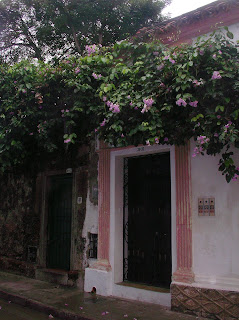
Scott and I have been walking into the center of the city most mornings as early as possible. We try to leave around 6:30 AM. Our walk starts along the harbor looking across to Boca Grande, the high rise wealthy condo community along the ocean front. The promenade is always busy with walkers and runners. From there we cross a bridge into the old city. On the corner there is an old battery and guard post. On Wednesday morning we didn´t get far before the heavens opened.


We took shelter under an overhanging balcony and waited. Taxis come in three major sizes here; bright yellow cars, motorcycles and bicyles with covered seats behind. The motorcycle taxis have two sets of vests and helmets, one for the paying passenger. They wear distinctive red or day glow orange vests and display their license plates numbers on both the vests and helmets. Odd numbers have one day and even numbers the next. Once a month no motorcycle taxis are allowed. Everyone warned us never to take one. There are accidents all the time. It rained so hard that most drivers pulled over and


waited out the storm. We shared our overhang with several. Vendors roam the streets with thermos of hot coffee, served in tiny plastic cups. We all had some and laughed together. Even in the rain the brilliant colors of the homes brighten up the gloom. This blue house is somewhat unusual, pink and yellow are more commen, but every shade is represented.

We had a brief break and walked further downtoen but only a half hour later the skies opened up again and we took shelter in a small cafe and ordered breakfast; scrambled eggs with veggies, fried plantains and bread. An ice vendor stopped just outside to break off a big chunk of ice for the owner of the restaurant. Vendors sell everything on the street here, including most services. You can get your shoes repaired, clothes altered and appliances fixed - all out on the street. Street food is very good, quick and stuffed with calories.

Most everything is fried. Fritters, fried doughs, arepas (corn cakes stuffed with cheese, eggs, meat or plain), and pastries of all kinds (meat, meat and potatoes, meat and potatoes and an egg etc.). Our favorite is the last one mentioned and it's a meal. Some of the fried dough is of course sweet - the latin version of doughnuts. Luckily they also serve fresh juices and fruits of all kinds so you can persuade yourself you are eating something healthy! Needless to say, my doctor is not going to be pleased with me when I return.


















































